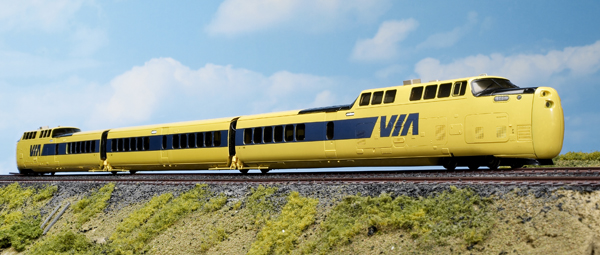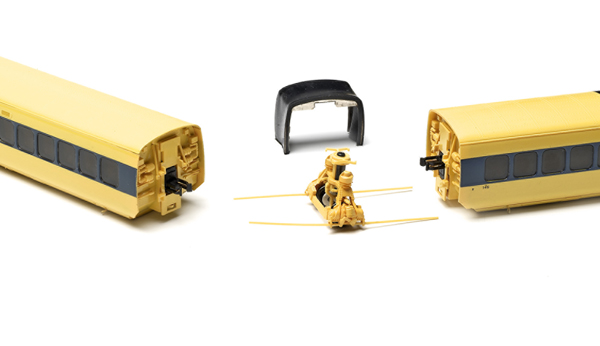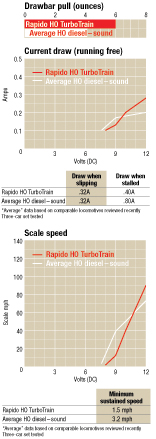The prototype. In the late 1960s as highways and airports became more congested, the TurboTrain was an attempt to bring modern high-speed rail travel to North America. Designed by United Aircraft Corp., the TurboTrain used jet turbine engines instead of diesel electric power. Each TurboTrain had a Power Dome Car (PDC) at each end and a number of Intermediate Cars (IC) in between.
The TurboTrains set speed records in both the United States and Canada, were popular with passengers, and eventually had high efficiency rates. Unfortunately early design flaws and accidents, poor maintenance, and lack of appropriate infrastructure for high-speed rail travel doomed the Turbo to a short service life.
Canadian National and later VIA Rail Canada operated TurboTrains from 1968 until 1982. In the United States, TurboTrain service lasted from 1968 to 1976. No TurboTrains have been preserved.
For an extensive history of the Turbos refer to TurboTrain: A Journey by Jason Shron. The 135-page book is included with each Rapido TurboTrain set.
The Rapido model’s dimensions are within scale inches of those listed in the March 1970 Trains.
The IC roofs are press-fit, allowing access to the car interior if you want to add passenger figures.
Paint coverage on the model is smooth and even. The separation lines of the blue logos and striping are crisp and all other printing is legible and straight. The blue striping lines up between cars when the train is coupled together.
The interior floors are painted a yellow-tan color. The seats are painted blue. All the car windows are flush fitting and tinted, which looks very realistic when the interiors are illuminated.
Other lighting effects include constant light-emitting diode (LED) headlights on each end that turn on automatically depending on the direction. A red Gyralite that serves as the marker illuminates automatically depending upon which end is the rear of the train.
There’s also a user-controlled forward Gyralite to the left of the marker on each end.
Out of the box the TurboTrain can negotiate 24″ curves. For operation on curves as tight as 18″ you’ll need to clip off the guidance rods or use the alternate truck sideframes (provided) that omit the guidance rods.
Like the prototype, the HO TurboTrain rides low and requires smooth trackwork. The model is unforgiving on uneven rails, steep grades, or tight curves.
Both PDCs have a can motor with a brass flywheel that powers the gearbox mounted on each two-axle truck. Both axles are powered. On our VIA Rail Canada version the two-axle truck has one traction-tire-equipped wheel per axle.
Each PDC also has a sound decoder with a single speaker mounted above the belly of the car. The PDCs and all the ICs have interior lighting.
In DCC using 28 speed steps the three-car set started moving in speed step 2 at 5 scale mph and reached a top speed of 180 scale mph, which is above that of the prototype. Once I added more ICs to make a full nine-car train, the model’s top speed was 120 scale mph. To limit the top speed of the model further, you can adjust its top voltage (CV 5) to a lower value.
In DC and DCC the model lurched at slow speeds. The lurching stopped once the model’s speed rose above 15 scale mph.
Sounds in DC and DCC. The TurboTrain’s dual-mode decoder lets you access sound effects in DC or DCC. The sounds are all top-notch from the prototypical turbine start up and shut down sequences to the distinctive horn that was given a discordant tone so it could be heard above the turbine. Many of the sounds, such as the turbine and horn, are taken from actual recordings of the prototype.
In DC the turbine sounds increase or decrease with the speed of the train. Other sound effects are accessible in DC using the five-button controller, including the horn, bell, and station announcements. The controller also has a shift key that lets DC users access additional sounds, such as the doors opening and closing. You can also turn on the forward Gyralite, change volume levels, and toggle between Canadian and American station announcements.
The range of the DC controller is limited. The controller worked reliably only when it was right next to the train.
The Rapido TurboTrain is a lot more fun to operate in DCC. The model supports Ops mode programming (programming on the main) and the instruction manual includes a list of CVs. The PDC’s must be programmed together or the model won’t function properly.
The model supports 28 functions in DCC. Along with the horn, bell, and lights, you can trigger a doors closing sequence and arrival and departure announcements. On our VIA Rail Canada Turbo the announcements are factory set to the Canadian version and given in both English and French.
Other function keys on the Turbo include function 8, which lets you increase the engine volume level, and function 12, which lets you toggle between American and Canadian train announcements. Functions 16 through 28 trigger additional announcements.
With Rapido’s extensive attention to detail and the array of realistic sound effects, this HO scale TurboTrain is a fitting tribute to its historic prototype.
Price: $499.95 (Additional intermediate cars, $39.95; intermediate car two-pack $69.95)
Manufacturer:
Rapido Trains Inc.
140 Applewood Crescent, Unit A
Concord, Ontario, L4K 4E2
Canada
Road names: VIA Rail Canada (1976-1982), Amtrak (early version, 1971-1973), Amtrak (late version, 1973-1979), Canadian National (1967-1976), New Haven/United States of Transportation (1967-1968), Penn Central (1968-1971)
All-wheel electrical pickup on Power Dome Cars (PDC) and Intermediate Cars(IC)(except on traction tire-equipped wheels)
Decal sheet for car numbers
Drawbar pull: 6.1 ounces (two PDCs)
Dual-mode Digital Command Control sound decoder in each PDC
Extra dual-axle wheelsets without traction tires (with traction tires on American road names)
Extra traction tires
DC sound controller
Five-pole skew-wound motor with flywheel in each POwer Dome Car
Metal RP-25 wheels mounted in gauge
Minimum radius: 24″ (18″ when truck sideframes without guidance rods are used)
Painted car interiors with lighting
Weight: 10 ounces (each PDC), 4 ounces (each IC)


















FEET OF CLAY
Rapido would have done better to forget prototypical fidelity and made a product that can actually be used on the majority of layouts, not the minority. I will admit it looks stunning sitting on the shelve while "lesser" models do the work on the Erie and Ohio. Customer Service is no great shakes at Rapido either, as my complaints about my examples faulty trucks remain unanswered.
Rick Smolecki
Great model – a carrying case or moveable cassette is a must if you want to avoid disassembly each time you remove it from a layout. It was a little rough running at first, but breaking in the motor helped considerably (I turned mine upside down and directly applied power to the wheels so it could run at full speed (something which can't happen on my layout))
I have purchased the Rapido's CN Turbo engine and car set.
I found this product to be full of great deal and performance.
The only thing I would say is, if you are going to be moving this product from layout to layout then build a carrying case so you only have to assemble the set once or you will have to replace parts over time.
Rapido as a company has great customer service along with a passion to detail.
Rapido does good work. Canadian modellers in particular are blessed to have people like Jason investing in producing high-quality models. One minor knock, as stated in the review, Rapido products in general require top-quality track work. But then, we MR readers all have top-notch track, right?
I hope the Turbo does well.
quelle belle histoire que la reproduction de ce train malheureusement disparu et pas encore remplacé
It's pretty nicely detailed but my sample runs so poorly that I've relegated it to display status.
Rapido did an awsome job modeling the interior of the model. two thumbs up
If the 'Turbo' is as good as previous products, this will be a 'super' model.
Have had an opportunity to use this company for
'customer service' and it was excellent and fast.
I so much enjoy watching the TurboTrain, as I did not see one in real life. The sounds are excellent and much detail in orgin.